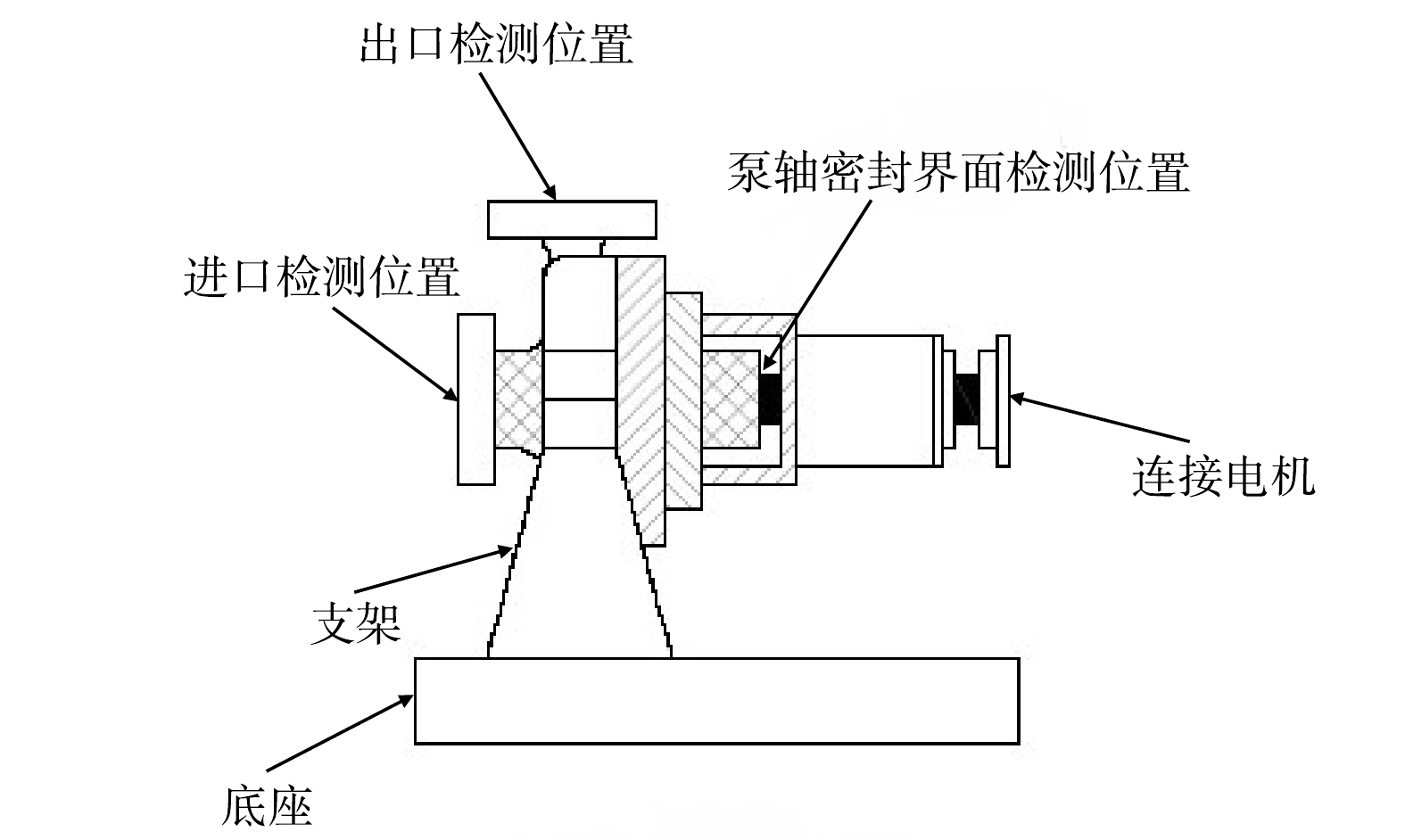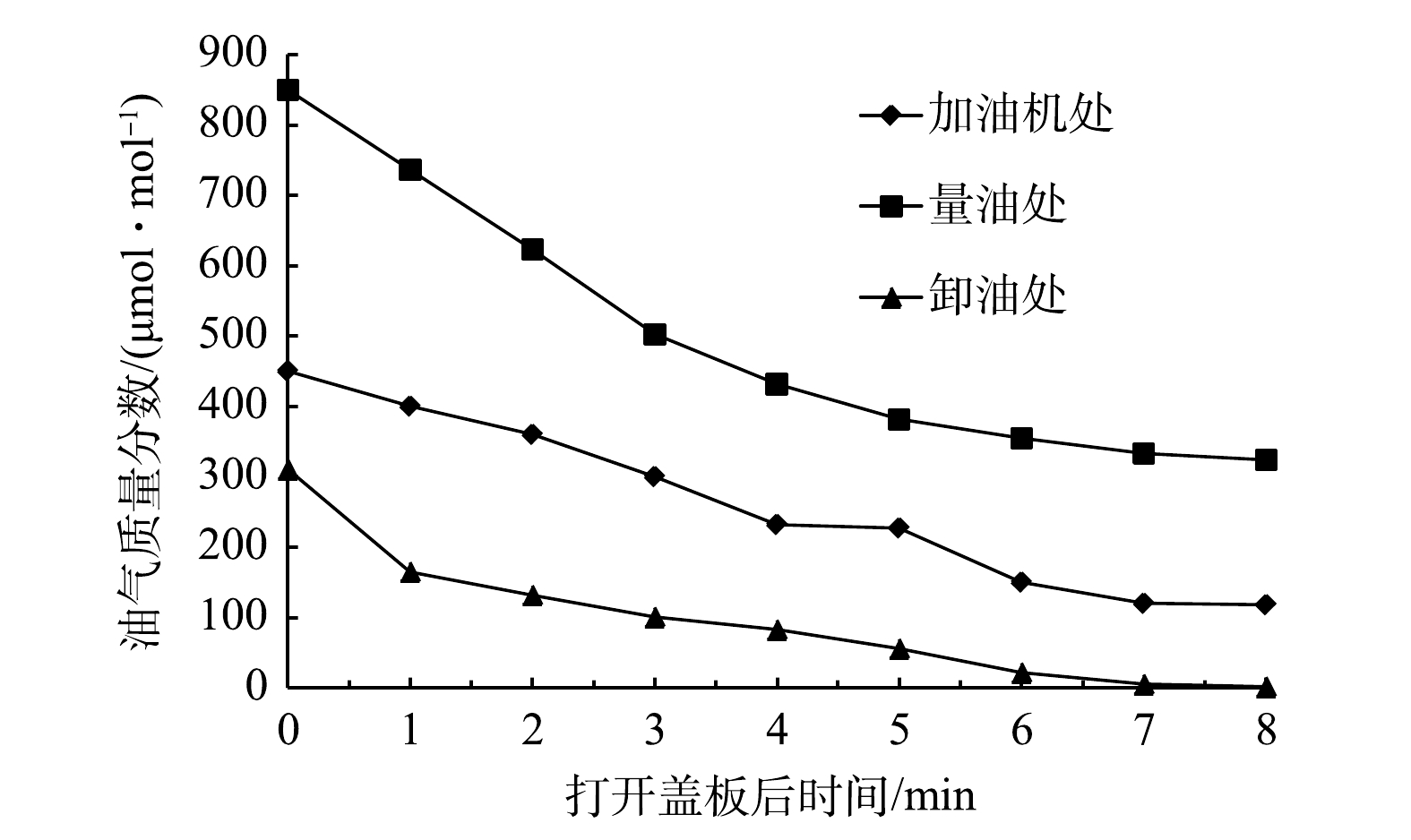-
随着我国成品油消费数量急剧上升,加油站数量也不断增加。据统计,中国加油站数量已经超过了1.2×105座[1]。加油站经营的汽油在运输、储存和销售过程中产生的油气[2],主要以沸点120 ℃以下的烷烃、烯烃、苯系物等碳氢类有机化合物为主,其中包含很多致癌物质,对人体及周边环境危害较大[3]。作为PM2.5与O3的重要前体物,烃类VOCs具有较强的挥发性[4-7]。VOCs的强活性特征决定了在条件合适的情况下会有光化学反应发生,氮氧化物在反应中可与VOCs结合产生臭氧[4,8-10]。因此,VOCs的检测是加油站空气污染防控的重要内容之一。
在20世纪70年代,美国相关企业就开展了对油气回收技术的研究[3]。1990年,美国联邦政府出台了相关法令,要求空气质量不达标区域的加油站须加装油气回收系统[11]。目前,全球环保领域公司研发的油气回收系统对加油站油气排放抑制的作用显著,为减少油罐及其附属设施的无组织排放发挥了重要作用[12]。为减少油气排放产生的VOCs对周边环境造成影响,我国自2016年前后开始要求加油站进行油气回收改造,并要求加油站定期对油气回收系统进行密闭性、液阻和气液比进行检测。为进一步减少加油站经营过程中的油气排放,我国新版《加油站大气污染物排放标准》(GB 20952-2020)中增加了油气回收系统密闭点位油气泄漏质量分数的检测项目,并要求在营加油站从2022年1月1日开始执行。
加油站挥发性有机物排放超标的主要原因是油气回收系统密闭点位存在损坏、泄漏等问题[13]。因此,如何及时、准确地发现超标排放的密闭点位置就显得尤为重要。中华人民共和国生态环境部组织编制的《工业企业挥发性有机物泄漏检测与修复技术指南》对加油站油气回收系统定期检测与修复提供了指导 [14] 。目前,加油站VOCs泄漏质量分数检测通常采用聚乙烯氟化物(PVF)气袋或苏玛罐对加油站油气回收系统密闭点进行取样并送入实验室,在实验室中采用气相色谱仪检测加油站油气回收系统密闭点油气泄漏质量分数,进而对加油站油气泄漏情况做出分析判断[15-16]。这种方法虽然可以对加油站VOCs的泄漏质量分数进行精准检测,但由于此方法操作步骤较为繁琐,并且要求取样48 h内完成检测,取样人员需要频繁地送样品到实验室,综合成本较高;同时气袋采样无法保证样品的代表性,无法及时有效地找出加油站油气回收系统超标排放的密闭点。
2021年,生态环境部和国家市场监督管理总局联合发布了《加油站大气污染物排放标准》(GB 20952-2020)并以此标准替代GB 20952-2007。在该标准中,对油气回收系统密闭点位油气泄漏质量分数值做出了明确要求。该标准要求任何时间段检测值均应≤500 μmol·mol−1,一旦在政府环保部门的检查中发现加油站密闭点油气泄漏质量分数值超标,加油站会遭受经济或行政处罚[17-18]。如何有效提高对油气回收系统油气泄漏质量分数检测数据的时效性、代表性与准确性成为亟待研究解决的课题。采用便携式氢火焰离子化检测仪(FID)检测油气泄漏质量分数,可以实现现场实时检测,具有检测效率高、数据代表性强、成本低等优势,成为加油站油气回收系统密闭点位油气泄漏质量分数检测的首选方法。
为提高检测效率并保证检测数据具有代表性,本研究在分析油气回收系统结构与已有检测仪器原理的基础上,提出一种既能保证检测数据准确性及代表性,又能有效提高检测效率并能准确找出超标排放密闭点位置的现场检测方法;探讨现场检测方法与实验室气相色谱法的区别;梳理现场检测的准备工作流程并对检测的对比结果进行讨论;分析现场检测的时效性和代表性、数据的准确性及质量保证和控制效果。本研究结果可为加油站采用FID现场检测油气回收系统VOCs泄漏气体提供参考。
-
本研究采用便携式氢火焰离子化检测仪(FID)检测油气泄漏质量分数。FID是以氢气与空气燃烧生成的火焰为能源,使有机物发生化学电离,并在电场作用下产生电信号来进行检测[19-20]。当载气携带被测组分从色谱柱流出后,与氢气按照一定的比例混合,一起从喷嘴喷出,并在喷嘴周围空气中燃烧;以燃烧所产生的高温(约2 100 ℃)火焰为能源,被测组分在火焰中被电离成正离子和负离子,在极化电压形成的电场作用下,正负离子分别向负极和正极移动,形成离子流。离子流强度很小,一般为10−8 A,这些微电流经过微电流放大器放大后被记录下来,信号的大小在一定范围内与单位时间内进入检测器的被测组分的质量成正比,从而测定出被测物的质量分数。
-
检测人员到达加油站现场接受加油站入场安全培训后,开始勘察加油站油气回收系统工艺线路,确定需要检测的密闭点,并将密闭点的名称和照片录入到防爆手持终端,对各个点位进行唯一性编号;建档完成后,就可以开展现场检测。具体操作要求:检测前做好风向风速判定、设备状态判定、设备校准;检测时及时将检测数据上传;检测后应检查设备漂移;当发现泄漏点超标时,及时通知加油站维修;修复后进行复测,复测合格后出具检测结果报告。此外,加油站油气回收系统密闭点泄漏质量分数检测还需要遵循以下几个方面的要求。
1)检测仪器的性能要求。现场使用的便携式氢火焰离子化检测仪必须满足以下几项要求:FID经过有校准资质的检定机构校准合格后方可使用;FID的量程应能满足加油站油气排放质量分数限值的测定要求,分辨率应保证质量分数限值的±2.5%范围内可读;FID校准时示值相对误差必须在±10%范围内,响应时间不应超过30 s;FID必须通过防爆安全检验认证。
2)检测人员的要求。现场检测人员一般由2名取得油气回收项目资格证书的检验员组成,1人检测,1人复核。检测人员穿戴防静电工作服,严格执行加油站各项安全规定。
3)检测点的选取要求。通过对加油站油气回收系统结构的分析,可以得到容易产生泄漏的部位,主要包括人工量油口端盖、卸油口、油气回收口盖帽、集液罐管口、加油机油气回收管和阀门处、真空泵、排放管压力/真空阀(关闭状态时)、与油气处理装置连接的管道连接法兰、阀门等部位,同时还要检测在卸油过程中与油罐车连接的接口、管道等密闭点位。
4) FID仪器的操作要求。为保证检测数据的代表性,检测时将FID检测探头放置于确定好的密闭点周围,并沿其外围以小于10 cm∙s−1的速度移动,同时关注仪器读数。如果发现读数上升,放慢检测探头移动速度直至测得最大读数,并在最大读数处停住,停留时间约为仪器响应时间的2 倍,记录最大读数。
5)泄漏点状态的稳定性要求。加油站的一些密闭区域,由于长期的油气聚集,油气质量分数往往很高,故检测时须提前打开密封盖板通风,检测时才能真实反映密闭点位的泄漏质量分数值。
-
1) FID使用前的校准。为提高加油站油气回收系统密闭点油气泄漏质量分数检测的准确度,每次检测前需要对氢火焰离子化检测仪进行校准。校准时,使用零气(VOCs质量分数<10−5 μmol·mol−1(以甲烷计)的清洁空气)和3组标准气体(甲烷)完成对仪器示值相对误差的测定。其中,测得的仪器示值相对误差必须在±10%范围内。
在仪器预热和零气校准后,向FID检测探头通入校准参考化合物标准气体(甲烷)。待仪器读数稳定后,按标准值来调节仪器读数。如果仪器读数无法调整到合适的质量分数值,表明仪器有故障,在使用前应予以排除。进行多点校准,标准质量分数限值均应在校准值的范围之内。
反复3次测定零气和同一质量分数的校准参考化合物标准气体(甲烷),仪器示值相对误差的计算方法见式(1)。
式中:
$ D $ 为仪器示值相对误差;$ {c}_{i} $ 为仪器 i 次测量的示值平均值;$ {c}_{\mathrm{s}} $ 为校准参考化合物标准气体质量分数值,μmol∙mol−1。依据《泄漏和敞开液面排放的挥发性有机物检测技术导则》(HJ 733-2014)[21]的规定,当仪器示值相对误差在±10%范围内时,检测仪器准确度才能满足要求。2) 响应时间的测定。检测前,还需要对FID响应时间进行测定。响应时间是指FID测定VOCs泄漏质量分数时,从仪器读数开始变化到仪器最终显示稳定读数的 90%所需要的时间。依据《泄漏和敞开液面排放的挥发性有机物检测技术导则》(HJ 733-2014)[21]的规定,FID响应时间应不超过30 s。
在测定响应时间的过程中,使用数值为1 990 μmol∙mol−1的标准气体,检测人员使用机械秒表记录测定时间。检测时,将检测泵、检测探头和过滤装置安装调整到位,从检测探头口通入零气,待氢火焰离子化检测仪读数稳定后,迅速切换通入校准气体,记录人员观察记录仪器达到最终稳定显示读数的 90%(1 791 μmol∙mol−1)所需要的时间。重复进行3次上述操作,取平均值作为该仪器的响应时间。
3) 检测点位的选择。检测点位的选择对于检测数据的准确性以及确定油气回收系统超标排放密封点位置至关重要。检测点包括阀门、法兰及其他连接件、油气回收真空泵、开口阀和开口管线4部分。
①阀门。阀门是加油站最常见的设备,加油站油气回收系统阀门通常检测的部位包括阀杆与填料压盖之间的密封、填料压盖或压板与阀盖之间的密封、阀盖与阀体之间的密封和其他可能泄漏VOCs的部位。具体检测部位如图1所示。检测人员首先将检测探头置于阀杆填料压盖处,沿其界面周围移动进行检测;然后将检测探头置于填料压盖下的法兰连接部位,在其外围移动进行检测;最后对阀体可能发生泄漏的其它连接界面进行检测。
②法兰及其他连接件。现场检测人员在检测时,应将检测探头置于法兰垫圈处,沿其外围移动进行检测,检测探头应尽可能插入两法兰之间的缝隙进行检测。如果检测探头直径超过缝隙宽度,则应将检测探头紧贴两法兰之间的缝隙,并与密封边缘垂直。连接件(螺纹接头)检测探头同样应与密封边缘垂直,并与管线走向呈30°~60°。对于活接头,接头两侧都应检测。法兰和连接件检测位置见图2。
③油气回收真空泵。加油站油气回收真空泵是转动设备,转动密封部位容易泄漏油气,因此,检测人员应在泵轴杆和密封界面处来回移动检测探头进行检测。如果是旋转轴,检测探头放置在离轴杆密封界面1 cm内进行检测;如果由于其构造的外形原因而无法完整地对阀杆周围进行检测,则应对所有可以检测的部位进行检测。对真空泵可能发生油气泄漏的所有连接处都应进行检测,具体检测位置如图3所示。
④开口阀和开口管线。加油站开口阀和开口管线主要包括人工计量口端盖、卸油口、集液罐管口、排放管压力/真空阀以及在卸油过程中与油罐车连接的接口等部位,现场检测人员须将检测探头置于其开口处与空气接触区域的中心部位进行检测。
-
为验证检测数据的准确性与重复性,对所选取的郑州市某加油站现场1#、2#油气回收系统15个密闭点位进行了检测并完成仪器校准和响应时间的测定。通过现场勘查后,确定加油站油气回收系统需要检测的密闭点位,即可进行密闭点位泄漏质量分数的检测工作。
-
首先,对实验所用仪器进行校准。FID显示的最大示值相对误差为-0.7%,满足技术导则要求,校准误差结果如表1所示。
其次,对该加油站使用的FID检测仪响应时间进行3次测定。响应时间分别为10、12和14 s。仪器响应平均时间为12 s,满足技术导则的要求。
第三,对密闭点油气质量分数进行检测。在FID满足技术导则的要求后,对该加油站油气回收系统密闭点位油气泄漏质量分数进行检测。现场检测时应将加油机下部盖板、量油作业区的人孔盖、卸油区的盖板及罐区操作井盖板提前打开,保证密闭区域聚集的油气通过自然通风扩散,否则,检测质量分数会偏高且数据显示不稳定,缺乏代表性。图4反映了打开密封区域盖板后不同时间段FID的检测值趋势。
第四,对仪器精密度进行验证。通过检测甲烷标准气体验证FID的精密度。实验中甲烷标准气体质量分数分别为500.7 μmol∙mol−1和9 998.5 μmol∙mol−1,同一操作人员分别连续进行6次重复测量。据表2数据计算出了相对标准偏差RSD。计算结果表明,本次实验的相对标准偏差分别为0.69%、0.16%,远远小于10%。
-
FID现场检测法和实验室气相色谱检测法原理相似,不同点在于检测的时效性不同。FID检测可以在加油站现场实时完成;而实验室气相色谱法需要现场取样后,送到实验室分析才可以得到泄漏质量分数值。
为进一步验证2种方法测量准确度与检测效率,对选定的密闭点采用气袋法采样并送实验室进行了检测。检测时,检测人员使用PVF气袋在每个密闭点的不同部位取4个样品,共取样品60个,取样用时约3 h。取样后,立即将样品送实验室并使用气相色谱仪进行检测,检测用时约3 h。同时使用FID在相同密闭点的4个不同部位进行现场检测。具体检测数据见表3。
由表3可以看出,与实验室气相色谱法相比,采用现场检测方法所测量的不同密封点VOCs泄漏质量分数最大值偏差在5%以下,最大值偏差大的密封点位主要是泄漏质量分数值很低的检测点,远远低于排放限值,且2种方法反映的质量分数值基本一致。
-
由表3还可以看出,加油站油气回收系统容易发生泄漏的部位包括真空泵附近的油气回收管线弯头、量油口及其下部的法兰等密闭点,其检测质量分数值均>100 μmol∙mol−1。由油气回收的工作原理可知,与油气回收系统相连接的储罐内一直处于微正压,密闭点的密封性是预防泄漏质量分数超标的重要环节。对于自吸式加油机,在其下部同时安装有自吸泵、计量器和真空泵等转动设备,运转时产生的振动,会造成通过丝扣连接的油气回收管线弯头密闭点产生松动,易引起泄漏质量分数超标。在加油站日常经营过程中,为监控油品损溢,计量员每天需要打开量油口量取储罐内油品的液位。由于打开阀门时单向施力的作用,长期积累会造成量油口下部的法兰连接螺栓松动并容易引起这些密闭点泄漏质量分数超标。加油枪气液比是加油站油气回收系统最关键的参数,如果设置不合理,会造成储罐内油气压力增高,也容易引起密闭点泄漏质量分数超标。
为确保加油站油气回收系统易泄漏密闭点的密封性完好,加油站应采取以下防范措施:在油罐上设置液位仪,取代人工计量,可以最大限度地降低量油口的打开频次;设备管理人员应定期对加油机下部的设备进行维护保养,避免振动超标;每月使用铜扳手对真空泵附近的丝扣连接和量油口附近的法兰连接螺栓进行紧固;对量油口球阀定期维护保养,避免阀门打开时施力过大;结合实际检测工作,合理设置气液比,建议设置在1.05~1.15。
-
采用现场取样送实验室检测的方法,依据有关取样规范要求,取样数量为120~200个,单站取样时间约1 d,取样完成后送回实验室检测及数据处理时间约2 d,完成1座加油站的检测需要3 d左右。采用FID现场检测时,仅需1名人员检测,另1名人员监督复核。通过防爆手持数据终端直接记录检测数据,方便检测数据的溯源。通过数据接口将检测数据导入已编制好的检测报告模板中,从而快速生成检测报告,缩短了编制时间。按照检测质量控制要求,每天开始检测前,检测人员需要对FID进行标准气体校准,一般用时为 20 min左右,每站现场检测需要1 h左右,每天大约可以检测5座加油站,检测效率是前者的15 倍左右。检测成本的核算主要包括参与的检测人员、交通运输、检测仪器和耗材等费用,采用现场取样送实验室检测的单站费用为5 000~6 000元,而采用现场检测法可以随密闭性、气液比和液阻3项指标一起进行,单站费用仅需要500元左右,费用是前者的1/10,可以极大地降低检测成本。所以,采用FID检测加油站油气回收系统VOCs泄漏质量分数效率高、成本低、时效性强。
-
由表1可以看出,现场实验所使用的FID最大示值相对误差为-0.7%,标准气体校准相对误差远低于《泄漏和敞开液面排放的挥发性有机物检测技术导则》(HJ 733-2014)规定的限值。FID响应时间均优于前述技术导则的要求。根据表2数据计算出的FID2种不同标准气体检测的相对标准偏差RSD,分别为0.69%和0.16%,RSD值远远小于10%。所以,采用FID现场检测法能够满足密闭点VOCs质量分数检测准确度的要求。
为进一步说明现场FID检测方法得到的数据与目前通用的气袋现场采样后送实验室检测方法在精度上无明显下降,在该加油站油气回收系统的关键点进行采样,得到的数据见表3。通过对比可以看出,采用现场检测方法对比现场取样后送检方法,最大质量分数偏差绝对值基本在5%以下。
-
由图4可以看出,加油机量油口聚集了较大质量分数的油气,当盖板打开后,随着时间的推移,油气快速扩散,7 min左右FID显示值趋于稳定,基本能够显示密闭区域内密闭点的泄漏状态。所以,为保证检测数据的代表性,降低检测时所带来的随机误差与系统误差,检测人员在密闭区域检测时,应提前打开密闭区域内的盖板,以便聚集的油气扩散后再开始检测。
-
便携式FID属于移动检测设备,仪器工作环境无法达到实验室的环境条件,并且经常放置到机动车上,随道路的起伏而颠簸,因此,保证仪器的准确性及稳定性显得尤为重要。为做好检测质量保证和控制,FID在出库、入库时,检测人员和设备管理人员应共同检查设备是否完好,校准证书是否在有效期内,并使用零气和标准气体进行校准,一旦发现示值误差超过最大允许误差,检测人员应当对存在疑问的检测项目重新安排复测。检测人员使用FID现场检测时,每天检测前应使用零气和标准气体进行仪器校准,仪器示值误差必须小于10%,一旦发现超差,需要查找原因,并对前1 d的检测项目进行复测。现场检测时采样探头在待测设备外围移动不能过快,避免漏掉最高质量分数点。变换待测源时,在下一个待测源检测开始前,检测人员应确定FID是否处于待测状态。
-
1) 采用现场检测方法对油气回收系统密闭点进行检测对比现场采样后送实验室检测,检测成本可降低90%,检测效率可提高15倍左右,同时通过对关键点位的检测可以及时在现场排查出超标排放的密闭点位置,有利于及时进行维修。
2) 检测前完成仪器的校准、响应时间的测定与精密度的验证工作,可使加油站油气回收系统密闭点VOCs最大质量分数偏差维持在5%以下。
3) 为保证检测质量与准确度,并确保FID现场检测示值相对误差在±10%范围内,须对检测设备的定期校准,检测仪器响应时间不超过30 s。
4) 容易发生泄漏的位置主要来自于真空泵附近的油气回收管线弯头、量油口及其下部的法兰等密闭点,可通过采取液位仪自动计量技术、加强设备的维护保养和合理设置加油枪的气液比等有效防范措施,确保易泄漏点的密封完好。
加油站油气回收系统VOCs泄漏FID现场检测方法及效果分析
Effect analysis of FID field detection method for VOCs leakage in oil and gas recovery system of gas station
-
摘要: 油气回收系统密闭点VOCs泄漏质量分数值是衡量加油站是否存在超标排放的重要指标。为提高加油站VOCs泄漏检测的时效性、代表性与准确性,采用FID现场检测方法对郑州市某加油站油气回收系统进行了检测,全方位对比分析了实验室气相色谱法与现场检测法的检测时效性、准确性,提出了密闭区域检测及质量保证和控制建议,并根据实际检测数据分析了易泄漏点。结果表明:采用FID现场检测方法对油气回收系统密闭点进行检测,能使检测成本降低90%,检测效率提高 15 倍;在现场检测前完成仪器的校准、响应时间的测定与精密度的验证工作,可使VOCs最大质量分数偏差维持在5%以下,这进一步验证了FID现场检测方法测量的准确度;油气回收系统泄漏点的确定及现场检测流程和步骤的优化,可有效提高检测数据的代表性;检测设备的定期校准,可确保FID示值相对误差在±10%范围内,响应时间不超过30 s,从而为检测质量控制提供保障;为确保泄漏点完好,结合实际检测工作,应采用液位仪自动计量技术,加强设备的维护保养并设置加油枪气液比为1.05~1.15。综上所述,在保证FID的准确性与稳定性的前提下,采用FID现场检测方法对油气回收系统VOCs泄漏质量分数进行检测具有时效性强、准确度高、数据代表性强等优势。本研究结果可为加油站采用FID现场检测油气回收系统VOCs泄漏的质量分数提供参考。Abstract: The mass fraction of VOCs leakage at the sealing point of the oil and gas recovery system is an important index to judge whether the gas station has excessive emissions. In order to enhance the timeliness, representativeness and accuracy of detecting the VOCs leakage at gas station, FID field detection method was used to test the oil and gas recovery system of a gas station in Zhengzhou, an all-round comparative analysis was made on the timeliness, accuracy of laboratory gas chromatography and field detection methods. Then the proposals for the closed area detection and quality assurance and control effect were provided. And the easy leakage points were analyzed according to the actually measured data. The results showed that using FID field detection method to detect the sealing point of oil and gas recovery system could reduce the detection cost by 90% and improve the efficiency by 15 times. Before the field detection, the instrument calibration, the response time measurement and the precision verification were completed, the maximum mass fraction deviation could maintain below 5%, which further proved the measurement accuracy of FID field detection method. The determination of leakage point of oil and gas recovery system and the optimization of field detection process and steps could effectively improve the representativeness of detection data. The periodic calibration of testing equipment could ensure that the relative error for FID indication was within ± 10% and the response time was no more than 30 s, which could provide guarantee for testing quality control. Combined with the actual detection work, adopting the automatic measurement technology of liquid level instrument, strengthening the equipment maintenance and setting the gas-liquid ratio of refueling gun to 1.05~1.15 could ensure the the intact leakage point. In summary, on the basis of ensuring the accuracy and stability of FID, using the FID field detection method to detect the VOCs leakage mass fraction of oil and gas recovery system had the advantages of strong timeliness, high accuracy and strong data representation. This research can provide a reference for gas stations using FID to detect mass fraction of VOCs leakage in oil and gas recovery system.
-
Key words:
- gas station /
- oil and gas recovery system /
- FID /
- mass fraction of oil and gas leakage /
- field detection
-

-
表 1 郑州市某加油站仪器校准相对误差
Table 1. Relative error of instrument calibration in a gas station in Zhengzhou
气体 测量值/(μmol∙mol−1) 标准气体值/
(μmol∙mol−1)相对误差/% 第1次 第2次 第3次 零气 0 0 0 0 0 标准气体1 500.8 499.8 490.9 500.7 −0.7 标准气体2 1 987.2 1 980.1 1 975.0 1 990.1 −0.5 标准气体3 9 952.1 9 933.6 9 914.7 9 998.5 −0.6 注:零气为VOCs质量分数<10−5 μmol·mol−1(以甲烷计)的清洁空气;示值误差小于10%,说明仪器满足标准要求。 表 2 精密度质量分数检测数据
Table 2. Precision for mass fraction detection data
检测
次数样品1质量分数/(μmol∙mol−1) 样品2质量分数/(μmol∙mol−1) 标准值 检测值 标准值 检测值 1 500.7 510.4 9 998.5 10 012.1 2 500.7 508.1 9 998.5 9 994.7 3 500.7 511.7 9 998.5 10 035.9 4 500.7 503.9 9 998.5 9 998.2 5 500.7 509.3 9 998.5 10 028.4 6 500.7 502.6 9 998.5 10 016.6 表 3 加油站油气回收系统密闭点VOCs泄漏质量分数检测结果
Table 3. VOCs leakage mass fraction detection result at sealing points of oil and gas recovery system in gas stations
采样区域 泄漏点 FID现场检测泄漏质量分数/(μmol∙mol−1) 实验室检测泄漏质量分数/(μmol∙mol−1) 偏差/% 检测值1 检测值2 检测值3 检测值4 最大值 样品1 样品2 样品3 样品4 最大值 加油区 1#枪油气回收铜管连接口 33.6 37.6 32.3 32.3 37.6 32.5 35.2 30.3 31.3 35.2 6.4 加油区 1#枪油气回收检测口 2.0 3.0 1.9 2.4 3.0 1.5 2.3 1.3 2.2 2.3 23.3 加油区 1#枪油气回收管线弯头 208.1 209.2 227.1 226.5 227.1 203.8 205.9 223.2 221.4 223.2 1.7 加油区 2#枪油气回收铜管连接口 0.3 0.4 0.3 0.4 0.4 0.2 0.3 0.2 0.3 0.3 25.0 加油区 2#枪油气回收检测口 0.2 0.2 0.2 0.2 0.2 0.2 0.2 0.2 0.2 0.2 0 加油区 2#枪油气回收管线弯头 209.1 229.2 217.9 207.1 229.1 203.8 221.2 214.3 202.4 221.2 3.4 储油区 油气回收接口 0.5 0.5 0.4 0.3 0.5 0.5 0.5 0.3 0.3 0.5 0 储油区 1#卸油口 1.6 1.4 1.7 1.4 1.7 1.5 1. 1.6 1.4 1.6 5.9 储油区 2#卸油口 0.3 0.3 0.2 0.2 0.2 0.2 0.2 0.2 0.2 0.2 0 储油区 1#罐量油口 181.2 172.3 174.9 179.6 181.2 178.3 168.1 172.4 172.7 178.3 1.6 储油区 1#罐量油口法兰1 356.3 345.4 342.1 359.9 359.9 353.4 342.3 332.1 356.1 356.1 1.1 储油区 1#罐量油口法兰2 379.3 371.4 379.8 374.4 379.8 378.2 368.3 379.2 372.8 379.2 0.2 储油区 2#罐量油口 201.4 203.1 197.9 201.4 203.1 197.7 200.8 197.3 199.1 200.8 1.1 储油区 2#罐量油口法兰1 325.2 327.9 326.8 329.2 329.2 322.8 325.7 318.3 326.9 326.9 0.7 储油区 2#罐量油口法兰2 378.1 379.2 379.9 377.4 379.9 375.8 376.2 376.1 368.8 376.2 1.0 -
[1] 《中国化学工业年鉴》编辑部. 中国化学工业年鉴2017-2018[M]. 北京: 中国化工信息中心, 2019. [2] SIGUT M, ALAYON S, HERNANDEZ E. Applying pattern classification techniques to the early detection of fuel leaks in petrol stations[J]. Journal of Cleaner Production, 2014, 80(1): 262-270. [3] 何玉荟, 支国强, 李田富. 加油站油气回收技术研究[J]. 环境工程, 2016, 34(S1): 905-909. [4] THOMPSON A M, BALASHOV N V, WITTE J C, et al. Tropospheric ozone increases over the southern Africa region: Bellwether for rapid growth in Southern Hemisphere pollution[J]. Atmospheric Chemistry and Physics, 2014, 14(18): 9855-9869. doi: 10.5194/acp-14-9855-2014 [5] SHAO M, LU S, LIU Y, et al. Volatile organic compounds measured in summer in Beijing and their role in ground-level ozone formation[J]. Journal of Geophysical Research:Atmospheres, 2009, 114(D2): D00G06. [6] ZHANG Q, YUAN B, SHAO M, et al. Variations of ground-level O3 and its precursors in Beijing in summertime between 2005 and 2011[J]. Atmospheric Chemistry and Physics, 2014, 14(12): 6089-6101. doi: 10.5194/acp-14-6089-2014 [7] 蔡乐天, 许潇锋, 许纯领, 等. 宿迁市VOCs污染特征和来源解析[J]. 环境科学学报, 2021, 41(11): 4341-4352. [8] 陈天雷, 吴敏, 潘成珂, 等. 基于前体物多情景排放的兰州市2030年夏季臭氧预测[J/OL]. (2021-10-27)[2022-01-10]. 环境科学. https://doi.org/10.13227/j.hjkx.202108116. [9] 陈雪, 黄晓锋, 朱波, 等. 深圳市秋季VOCs空间分布特征与关键减排物种[J]. 中国环境科学, 2021, 41(9): 4069-4076. doi: 10.3969/j.issn.1000-6923.2021.09.012 [10] STOJIĆ A, STOJIĆ S S, ŠOŠTARIĆ A, et al. Characterization of VOC sources in an urban area based on PTR-MS measurements and receptor modelling[J]. Environmental Science and Pollution Research, 2015, 22(17): 13137-13152. doi: 10.1007/s11356-015-4540-5 [11] United States Environmental Protection Agency. Clean air act[S]. Washington DC: US EPA, 2013. [12] 王思宇, 黄玉虎, 胡玮, 等. 加油站油气处理装置作用及VOCs排放现状[J]. 环境科学研究, 2021, 34(2): 279-285. [13] 沈旻嘉, 郝吉明, 王丽涛. 中国加油站VOC排放污染现状及控制[J]. 环境科学, 2006, 27(8): 1473-1478. doi: 10.3321/j.issn:0250-3301.2006.08.001 [14] 中华人民共和国生态环境部. 工业企业挥发性有机物泄漏检测与修复技术指南: HJ 1230-2021[S]. 北京: 生态环境部环境标准研究所, 2021. [15] 王继钦, 陈军辉, 韩丽, 等. 四川省加油站挥发性有机物排放及控制现状[J]. 环境污染与防治, 2020, 42(6): 672-677. [16] 朱诗月, 赵朝成, 韩丰磊. 石化企业VOCs排放检测方法及影响因素研究[J]. 化学工业与工程, 2019, 36(4): 7-17. [17] 中华人民共和国国家环境保护总局, 中华人民共和国国家质量监督检疫总局. 加油站大气污染物排放标准: GB 20952-2007[S]. 北京: 中国环境科学出版社, 2007. [18] 中华人民共和国生态环境部, 中华人民共和国国家市场监督管理总局. 加油站大气污染物排放标准: GB 20952-2020[S]. 北京: 中国环境出版集团, 2020. [19] LUONG J, HUA Y, GRAS R, et al. In-situ methanation with flame ionization detection for the determination of carbon dioxide in various matrices[J]. Analytical Methods, 2018, 10(10): 1275-1279. doi: 10.1039/C8AY00079D [20] 高少华, 邹兵, 崔积山, 等. 基于氢火焰离子化检测仪响应因子的设备泄漏排放核算[J]. 化工环保, 2017, 37(6): 707-712. doi: 10.3969/j.issn.1006-1878.2017.06.020 [21] 中华人民共和国环境保护部. 泄漏和敞开液面排放的挥发性有机物检测技术导则: HJ 733-2014[S]. 北京: 中国环境科学出版社, 2014. -




 下载:
下载:







